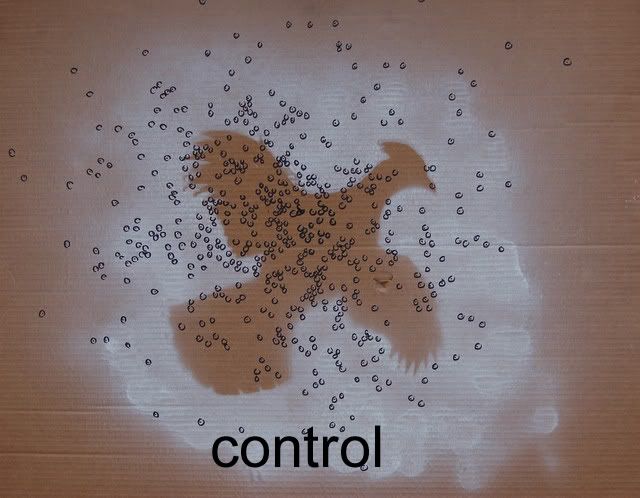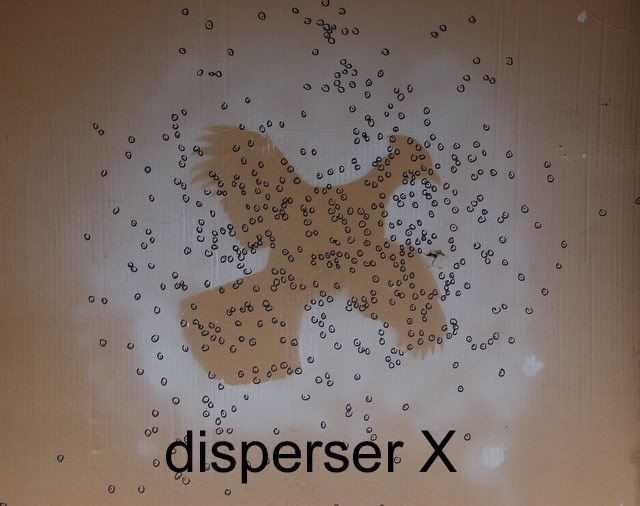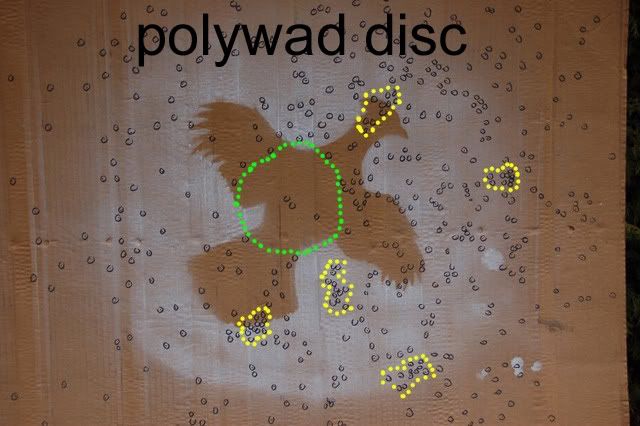I know that this has been discussed before, but........
I have a gun that is choked .030 and .030. I plan to use it for sporting clays mostly. Due to its originality and condition I will NOT open the chokes.
Now some of you use tighter chokes for clays and I will learn to do so, but there may be times that I want a more open choke.
So I may get back into reloading. What products have you used to get a more open pattern?
I know two options would be to use Briley sub-gauge tubes or shoot cheapie Mall Wort shells.
These would not be my first choices however.
Maybe I should just learn to shoot tight chokes
In a similar situation, I use a plastic POLYWAD insert on the top of my handloads, before crimping; and it works well. It opens the patterns.
This is a white plastic disc about the size of a dime, with a short post attached to it.
They are inexpensive, and effective.
If you don't handload, FIOCCHI makes a similar spreader load.
JERRY
A "cheapie Mall Wort" shell is made by one of the major manufacturers and has decent internal components so it WILL NOT shoot a wider pattern than a equiv AA Win load by any noticable amount. A big myth that they are of poor quality, IMO.
You didn't say what the gun was that you were discussing, but you did say you wouldn't open the chokes, so it must be either a vintage gun or a valuable gun as is. If it's a vintage gun, the Fiocci spreaders are all of relatively high velocity and likely high pressures. Give that some consideration before you use them in a vintage gun.
Handloading may be your best bet if low pressure is needed with a spreader.
Hello Mark, I use Fiocchi and Gamebore spreaders for serious sporting in my 21's. They use the same wad and are ~equivalent in performance. Either will open a pattern by 10-15% at 30"/40 yards and that's with any choke, not just tight ones. However they are much too hot for a vintage gun. I'm sure they're loaded to modern SAAMI max pressure ~ 12,000 psi. The only ones I can find nowadays are 1-1/8 ounce at 1250 fps and recoil is definitely there. Fiocchi used to make 1-1/8 ounce at 1200 fps which I much preferred but I believe they are off the market, at least I haven't been able to find them. When I shoot my Foxes with tight chokes for sporting I just use reloads with soft shot #8's or 9's for the closer birds. Actually that may be the best bet even with the 21's. Forces me to really concentrate on the sight picture I want. Frank
It's very easy. I use the X-stream from BPI. 2 cents per each. They take up the same room as 1/8 oz of shot, so use a wad with more capacity than you normally would, and just push these in the shot before you close the crimp.
They do not need to be seated before the shot is dropped, contrary to some opinion. This way, you can use a progressive loader like a Grabber just fine. I've been doing it this way for years, and it makes a fine spread load. I do use a small screwdriver to push them in far enough that they don't interfere with the crimp.
I'm doing the same, Shotgun---inexpensive and they work.
If you want low pressure spreader loads. Poly Wad makes them.
I believe they are called the "double wide" vintage Spred-r load. They are a 2.5 inch shell if I remember correctly.
Bryan
I use a large diameter drinking straw as a 'post' after the shot is dropped; opens up mod to full fine. Sorry, I don't have any statistics other than pattern at 30 yds is larger.
Pattern Control post wad similar to discontinued Remington post wad. Home fabbed cardbd. equivalent of the X-stream.
jack
I picked up a flat of Spred-R 1 1/8 ounce #7 1/2 shot 12-gauge 2 3/4 inch loads at the going out of business sale at the old Potomac River Gun Club. I used some of them in my Father's old tightly choked 2 frame Parker Bros. waterfowl gun. I shot a couple of patterns with each barrel and in that particular gun the results were very patchy. Just my experience with a very limited test. Maybe in a different barrel they would give better results.
Mike, very nice work and great visual aids. I'm sure it took a lot of time and I for one appreciate your effort. Just wondering, what were the distance(s) of the circle testing and of the birds in flight? I like how you showed that clumping on the last flying bird. (Private joke - like I blurred that reflection in the B-W trophy pic, MODERN TECHNOLOGY!) Frank
I use the Gailandi X-post wad.

Comparable pattern conditions for a full choke barrel with a CB Lightening wad:

and a spreader wad.

As long as yo are willing to load, case/color/sticker code, and carry two types of shells, you have no need to cut chokes. i found this combo in a full-mod gun very effective at last VC.
Frank,
FWIW, neither session was shot with a game gun. The large grouping was shot with my 12ga O/U comp gun with (virtually) fixed chokes of .018/.018 at 15 yds; the 3 bird targets were shot with my 16ga SxS comp gun with fixed .016/.016. The purpose was to visualize the relative merits of different spreader technologies, as opposed to finding a task-specific load. I might add that in a separate session I tried the multi-colored centerpost wad (similar to the soda straw technique)and found virtually no spread relative to a control, with perhaps a negligible disruptance of the core.
I don't employ spreaders for hunting, preferring 2 barrels, 2 different chokes and possibly 2 different loads to achieve as near perfect patterns as I can at 2 common distances for the game involved. In other words, my grouse 20 is choked .005/.015 and the patterns at 20 and 30 yds respectively, with the same 1 ounce of #7.5, are virtually identical. I haven't destroyed a woodcock or grouse since I made that choice, and I doubt anyone would suggest I'm undergunned. Likewise, my pheasant 12 is choked .015/.025 for first and second shots at 25 & 45 yds, but with #6 and #4.
My hunting shots are much more predictable than a clays course and my method for being prepared for any target is to choke both barrels for the longest shot I'm likely to encounter.
For the last decade my sporting clays philosophy has been 2 chokes.....no-choke for ridiculously close and one choke for everything beyond 15 yds. Basically cylinder and modified. But now I'm shooting fixed-choke Foxes almost exclusively, I've been interested in a spreader load that would duplicate a cylinder tube (or even threads). I think the disperser-X technology is really slick in that it produces the most even patterns (notice the absence of hot cores) I've ever recorded but really doesn't buy much additional pattern size inside 20 yds where I need it. The polywad disc gives the most dramatic pattern spread, but at the expense of severe patchiness, even the occasional donut pattern. I think they are much too risky for any straightaway target but offer perhaps the best option on a silly-ass crosser at 40 feet. Actually, that's not so bad. They really do help me on very short, fast rabbits but I distrust them so much I'm not likley to get dependent on them for other targets inside 20 yds. Also, the polywad is not dependent on high pressure and/or velocity; I get similar results with very mild loads.
best, Mike
FWIW....
for many years I made my own spreaders out of the sides of waxed milk cartons ala' BP's X-Stream design. They worked well and were always good for at least a 10% expansion in the tighter chokes, sometimes a bit more.
I've also patterned a bunch with the Poly-T device that Mike uses but can avoid that weak core by adding a small step in my loading procedure. Say that I want a 7/8 oz. spreader load using the Poly-T device.....then I'll set up with a 3/4 oz. charge bar for the main drop....insert the Poly-T device.... and then add the remaining 1/8 oz. via a small scoop made out of a .38 shell casing. Once the scoop is cut and deburred to a height that holds 1/8th oz., it's pretty easy to load at a similar speed. This can be done with any charge weight, just as long as you save 1/8th oz. of it to go atop the device.
The extra 1/8th of shot atop the disc eliminates any thin areas in the core, and if you doubt it, I suggest you take it to the patterning plate as you'll be pleasantly surprised. One-eighth oz. of shot in a 16 or 12 ga. virtually covers the top of the disc to a uniform depth of one pellet. So, it basically comes down to how big a hurry you are in when reloading. Sorry I've no comparable photos to illustrate this, but there it is......
Rob Harris
Rob,
That's pretty clever. I'm gonna try that and put em on paper. Since I remove the shell to insert the disc, topping it off with another 1/8 ounce should take virtually no extra time.
This is a really good thread. I don't have much to add, but patterns I've gotten with Polywad discs look just like Mike's. Bore constriction does not seem to matter. My .021 16 and .030 12 ga barrels throw cyl patterns with the Polywads discs.
My results with soda straw inserts are similar. Have not tried the Disperser X, but am intrigued by these - and by Rob's technique with Polywad discs.
Mike's ruminations about field choking are also spot-on.
I, too, would not not molest tight fixed chokes. It's easy enough to work around them.
Sam
Mike,
Good or bad, let us know what you find. I don't think you'll be disappointed as that 1/8th oz. cap of shot flies true without any dispersion effect. Good Luck with it, and am just sorry I don't have some patterns on picture file to show you.
Rob
Good job, Mike! Pictures are worth many thousands of words.
Thank you,
Thanks, Jim. It's all good fun.
Well, I tried Rob Harris' suggestion for layering with the Polywad insert and I have to say I'm impressed. It seems to combine the best features of Polywad and X-stream inserts. Polywad has given me the widest dispersion but with patchiness and sparse centers I find unacceptable. X-stream gives me the most even dispersion but relatively little additional width. I shot 4 patterns with each of the 2 recipes. The 4 with the bi-layer recipe were indistinguishable. Three of the 4 with the disc on top had large voids I've come to expect; I chose the one with the most circular void 'cause it was easy to illustrate.

I'm reminded that back in the 30's the best patterning ammo was roll-crimped with a disc on top. The "scatter loads" of the day were concocted with multiple layers of discs and shot. While the disc-on-top result quadruples my coverage, it does less for my confidence than the layered load. This layering technique opens the door to a lot of tinkering for handloaders so inclined. Thanks, Rob!
Are you fellows using the perforated Polywad inserts or the solid ones? Polywad sells both types.
Glad to be of help, Mike, and 'Thank You' for providing the pictures to prove it.
A shooting friend and I started playing with this separation of the shot column some years back when looking to improve upon the core-patchiness thrown by the Poly-T device. I have stayed with the 1/8th oz. amount since it pretty much affords a uniform layer of shot to a depth of just one pellet in the 12 and 16 gauges. I suppose a guy could try more volume of shot in the top layer but I didn't know if the jostling effect within those pellets upon (ignition)setback would start to degrade the pattern. Probably something I should have looked at, but I was getting such good results with the 1/8 oz. shot cap that I left it at that.
Mark,
I've been using the solid disc rather than the three-hole as I think the solid platform driving the 1/8 oz. may be a plus for performance. I've patterned the three-hole devices in the past on their own, and feel that they didn't do as well as this separation of the shot column I described earlier. You might prove me wrong on that, but that was my take on things after some time at the plate.
For clays (and especially game), I think it's worth the extra time when loading the Poly-T.
All Best,
Rob




